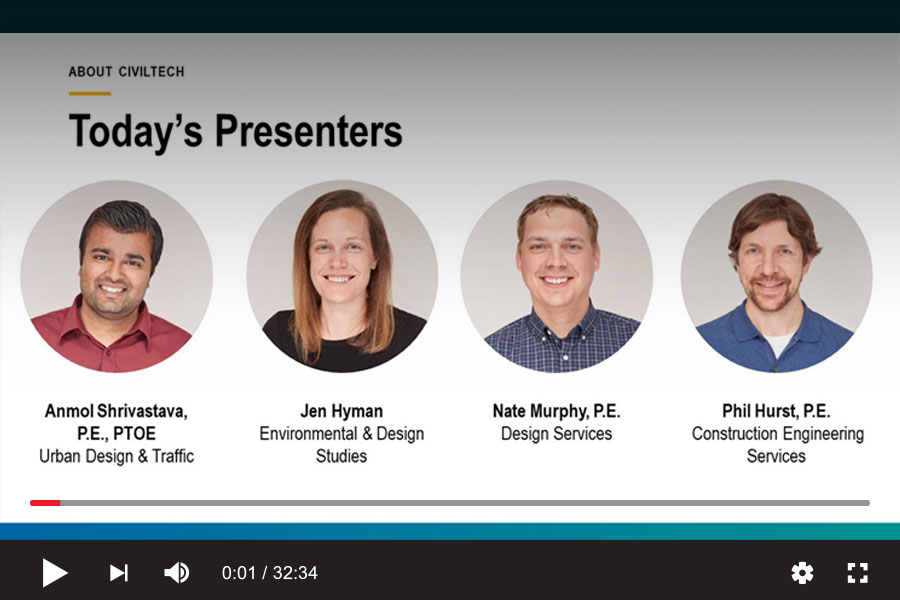
Civiltech’s Anmol Shrivastava, P.E., PTOE; Jen Hyman, P.E.; Nate Murphy, P.E.; and Phil Hurst, P.E. combined forces to prepare and present, “Rockland Road – A Virtual Shadow Day.”
Civiltech’s involvement in the Virtual Shadow Day began through Anmol Shrivastava’s, P.E., PTOE, volunteer work as the Student Affairs Director for the Institute of Transportation Engineers (ITE), Illinois Section. In this position, Anmol is active in career building and mentoring programs including career fairs, resume critiques, and networking events for college students and often volunteers to give presentations to pre-engineering students regarding a career in engineering. In the fall, Anmol was approached by Alexander George, a District-Wide Work-Based Learning Specialist with Chicago Public Schools (CPS), asking Civiltech to provide a virtual job shadow presentation which would allow students to learn about the Transportation Engineering field while schools and businesses continue to be remote. The goal was for the program to be distributed to pre-engineering students throughout the CPS system through their Career and Technical Education CAPTM (Construction, Architecture, Pre-engineering, Transportation, and Manufacturing) Team.
With COVID preventing on site job shadowing opportunities, Anmol thought the Virtual Job Shadow could provide insight for students to learn about the industry along with one of the many exciting projects Civiltech has worked on. Civiltech’s Rockland Road Improvements project was selected as a recent example of a project that involved all phases of Transportation Engineering.
The presentation included a PowerPoint slide show containing photos and graphics combined with audio by the team members. Anmol opened the presentation with an introduction of the team and a brief background of Civiltech. In his portion of the presentation, he explained the phases of the project’s life, from preliminary studies to construction. He also discussed how Civiltech employs a knowledge management program that includes lessons learned on projects.
Jen Hyman, P.E., who was the Project Engineer on the Rockland Road Phase I study, introduced the project parameters, goals, and challenges. Her presentation included project funding goals and all of the engineering and environmental studies that needed to be completed for the project to move forward. She explained all of the various types of data collection that were needed, including traffic counts, field surveys, historic plans, surveys, crash reports, and environmental data. She also explained that Phase I involves public meetings so that the community helps determine the design solutions to meet their needs and desires. Lastly, she explained how many agencies are involved in a project like this and that once all of the necessary approvals are obtained, a Project Development Report is finalized.
Nate Murphy, P.E., then picked up the narrative explaining how the Phase I study and data collection moves into Phase II in which construction plans, specifications, and cost estimates are developed. Nate explained how the Phase II engineers fine-tune the designs from Phase I for implementation. Also, in Nate’s presentation, he discussed the various types of drafting software utilized. Nate presented how once the roadway geometrics and profile are designed, the drainage design begins. This project involved exceptional and interesting drainage challenges.
Nate then passed the baton to Phil Hurst, P.E., who had served as Resident Engineer on the Construction Engineering portion of the project. Phil explained, “as field engineer, it’s my job to ensure the project gets built correctly according to the designer’s plans and specs. Besides that, we also have to solve any problems that may come up, be transparent with the stakeholders and residents about what type of construction is occurring on a daily basis, and measure and pay for the items the contractor completes each day.” Phil presented information on the four types of utility underground work that were included in the project, and how the project finishes out with new curb and gutter, landscaping, and finally new striping.
The Rockland Road Improvements Project Virtual Job Shadow gave CPS pre-engineering students a primer on some of the various careers available under the umbrella of Transportation Engineering. Also, the students got a detailed description of an interesting and challenging project, from preliminary studies and design through final construction.
